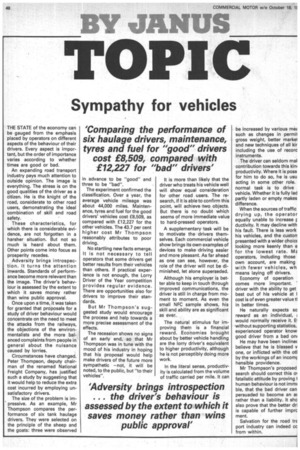TO P C
Page 50

If you've noticed an error in this article please click here to report it so we can fix it.
Sympathy for vehicles
'Comparing the performance of six haulage drivers, maintenance, tyres and fuel for "good" drivers cost £8,509, compared with £12,227 for "bad" drivers'
THE STATE of the economy can • be gauged from the emphasis placed by operators on different aspects of the behaviour of their drivers. Every aspect is important, but the order of importance varies according to whether times are good or bad.
An expanding road transport industry pays much attention to outside opinion. The image is everything. The stress is on the good qualities of the driver as a citizen. He is the knight of the road, considerate to other road users, demonstrating the ideal combination of skill and road safety.
These characteristics, for which there is considerable evidence, are not forgotten in a harsher situation. But not so much is heard about them. Other points come into focus as prosperity recedes.
Adversity brings introspection. It turns the attention inwards. Standards of performance become more relevant than the image. The driver's behaviour is assessed by the extent to which it saves money rather than wins public approval.
Once upon a time, it was taken for granted that proposals for a study of driver behaviour would concentrate on the need to meet the attacks from the railways, the objections of the environmentalists and the more balanced complaints from people in general about the nuisance caused by lorries.
Circumstances have changed. Peter Thompson, deputy chairman of the renamed National Freight Company, has justified such a study by suggesting that it would help to reduce the extra cost incurred by employing unsatisfactory drivers.
The size of the problem is impressive. As an example, Mr Thompson compares the performance of six tank haulage drivers. They were selected on the principle of the sheep and the goats: three were observed in advance to be "good" and three to be "bad".
The experiment confirmed the classification. Over a year, the average vehicle mileage was about 44,000 miles. Maintenance, tyres and fuel for the good drivers' vehicles cost £8,509, as compared with £12,227 for the other vehicles. The 43.7 per cent higher cost Mr Thompson reasonably attributes to poor driving.
No startling new facts emerge. It is not necessary to tell operators that some drivers get better results from their vehicles than others. If practical experience is not enough, the Lorry Driver of the Year competition provides regular evidence. There are opportunities also for drivers to improve their standards.
But Mr Thompson's suggested study would encourage the process and help towards a more precise assessment of the effects.
The recession shows no signs of an early end, so that Mr Thompson was in tune with the mood of his industry in hoping that his proposal would help make drivers of the future more sympathetic —not, it will be noted, to the public, but "to their vehicles". It is more than likely that the driver who treats his vehicle well will show equal consideration for other road users. The research, if it is able to confirm this point, will achieve two objects. But there is no doubt which seems of more immediate value to hard-pressed operators.
A supplementary task will be to motivate the drivers themselves. Each commercial vehicle show brings its own examples of devices to make driving easier and more pleasant. As far ahead as one can see, however, the role of the driver will not be diminished, let alone superseded.
Although his employer is better able to keep in touch through improved communications, the driver is still in charge from moment to moment. As even the small NFC sample shows, his skill and ability are as significant as ever.
The natural stimulus for improving them is a financial reward. Economies brought about by better vehicle handling are the lorry driver's equivalent to higher productivity, although he is not perceptibly doing more work.
In the literal sense, productivity is calculated from the volume of traffic carried per mile. It can be increased by various mee such as changes in permil gross weight, better markei and new techniques of all kir including the use of recorc instruments.
The driver can seldom mal contribution towards this kin+ productivity. Where it is poss for him to do so, he is usu acting in some other role. normal task is to drive vehicle. Whether it is fully lad partly laden or empty makes difference.
When the sources of traffic drying up, the operator equally unable to increase r ductivity. It may decline with his fault. There is less work his vehicles, and the custorr presented with a wider choice looking more keenly than e for the lowest rate. ME operators, including those own account, are making with fewer vehicles, wh means laying off drivers.
Economy of operation comes more important. driver with the ability to get best out of his vehicle at I cost is of even greater value ti in better times.
He naturally expects so reward as an individual, r would normally receive it. E' without supporting statistics, experienced operator keow. good driver from a bad on+ He may have been incline( believe that he is blessed v one, or inflicted with the oti by the workings of an incomi hensible providence.
Mr Thompson's proposed search should correct this ce, fatalistic attitude by proving 1 human behaviour is not immi We, that the bad driver can persuaded to become an ae. rather than a liability. It she also prove that the better dri is capable of further imprc ment.
Salvation for the road tre port industry can indeed cc from within.




























































































































































































































































































